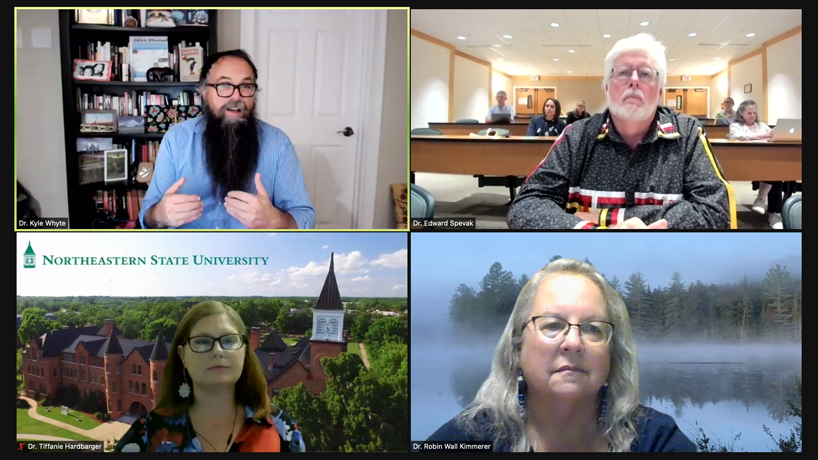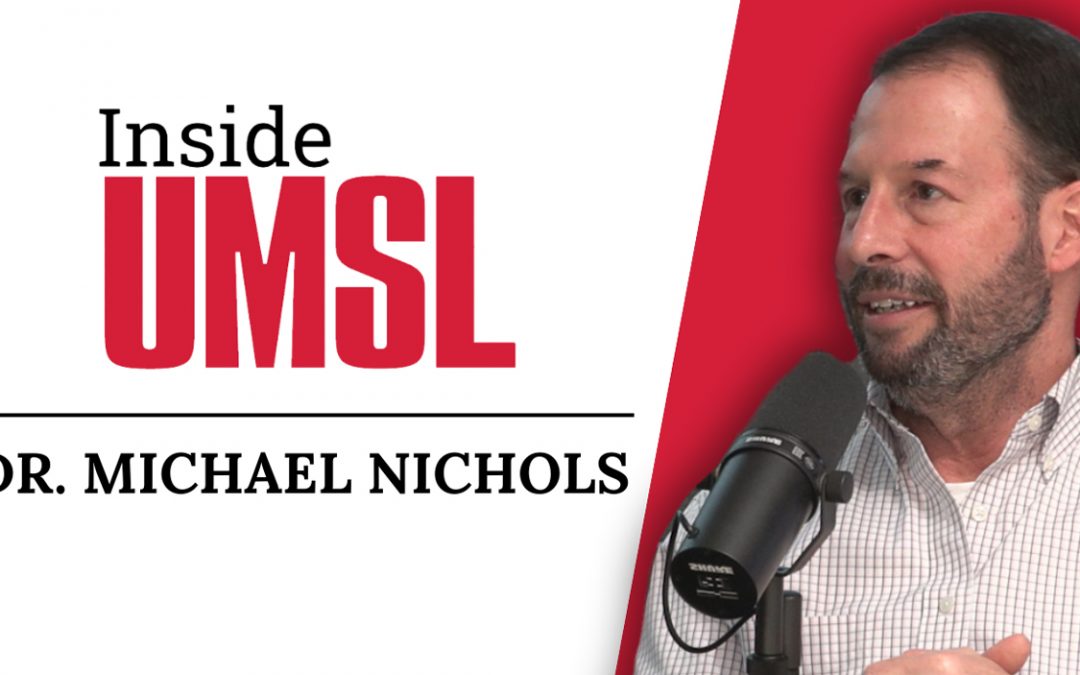
Kyle Whyte (top left), the George Willis Pack Professor of Environment and Sustainability at the University of Michigan, joined Tiffanie Hardbarger (bottom left), an assistant professor of Cherokee and Indigenous Studies at Northeastern State University, and Robin Kimmerer (bottom right), a distinguished teaching professor at the State University of New York College of Environmental Science and Forestry, as presenters in the 2021 Whitney and Anna Harris Conservation Forum. The Saint Louis Zoo’s Ed Spevak served as moderator for the event. (Screenshot)
The growth in human population and associated industrial development has put added strain on the Earth’s resources and has contributed to climate change, water scarcity, soil degradation and the destruction of biodiversity.
It’s led scientists and policy makers to think more intently about sustainability as they face the dangers of extreme weather, manifested in more severe droughts, flooding and wildfires, and work to ensure an adequate supply of food across the globe.
This 2021 Whitney and Anna Harris Conservation Forum explored what answers to these challenges can be gleaned from the knowledge of Indigenous people, who, for centuries, have maintained a more harmonious relationship with the world around them.
This year’s annual forum, held virtually last Thursday evening by the Whitney R. Harris World Ecology Center at the University of Missouri–St. Louis and the Saint Louis Zoo, was part of a five-day collaborative virtual conference “Indigenous Knowledge and Sustainability – Food.”
The conference was put on by a partnership that included the Harris Center and zoo as well as Southern Illinois University Edwardsville’s Native American Studies Program and Center for Spirituality & Sustainability, the Kathryn M. Buder Center for American Indian Studies at the Brown School at Washington University in St. Louis and the Missouri Botanical Garden.
“We wanted to look at a different way of interacting with nature because the worldview of the dominant culture – of our culture – is to use it,” said Harris Center Director Patricia Parker, the E. Desmond Lee Endowed Professor in Zoological Studies.
Attendees logging into Thursday’s conservation forum heard presentations from three university faculty members with Indigenous roots: Tiffanie Hardbarger, an assistant professor of Cherokee and Indigenous Studies at Northeastern State University in Tahlequah, Oklahoma; Robin Kimmerer, a distinguished teaching professor at the State University of New York College of Environmental Science and Forestry in Syracuse, New York; and Kyle Whyte, the George Willis Pack Professor of Environment and Sustainability at the University of Michigan.
Ed Spevak, the curator of invertebrates at the Saint Louis Zoo, guided the discussion as the evening’s moderator.
Hardbarger presented first and highlighted the European-American relationship to land and sustainability.
“When using the term sustainability, many may link the concept to the practice of sustainable development, as sustainability is often touted as the goal with sustainable development being the process in which to reach that goal,” she said. “The dominant paradigm within the development realm – even one that’s couched as being sustainable – still remains built upon very specific sets of value assumptions about how the world works.
“This often unquestioned way of viewing the world rests upon a specific foundation, and this foundation is an anthropocentric and hierarchical viewpoint that the earth is not only dead but that nature has no inherent value past the value that it can be extracted and gained for human pursuits.”
Indigenous culture, meanwhile, believes in reciprocity, as Kimmerer highlighted in her talk.
“We need to be able to give back in return for everything that we’ve been given and everything that we have taken,” she said. “But how do we do that? How do we reciprocate the gifts of the land? This question is fundamental to Indigenous pedagogy and to Indigenous philosophy but rarely present in our environmental science curricula.”
Kimmerer, author of “Braiding Sweetgrass: Indigenous Wisdom, Scientific Knowledge and the Teachings of Plants,” advocated for adopting the view that people belong to the land, rather than the other way around, leading to a moral responsibility care for it through their practices.
That does not mean leaving the land untouched. Rather, using the example of sweet grass, she shared an experiment that showed how traditional harvesting stimulated plant growth better than not harvesting at all.
Whyte discussed the importance of restoring a sense of kinship with the environment.
“We’ve been talking about climate change for generations,” he said. “It’s one of our oldest sciences, and we’ve understood ourselves as having a kinship relationship to the climate system. But it’s also a violation of kinship for a colonial society like the United States or other European powers to have taken actions that allowed for this dangerous industrialization to have occurred.
“But now in a lot of the work that I’m doing, we’re finding out that in a world that’s still absent of kinship across cultures, that many of the solutions to climate change are also engaged in land dispossession, in creating conditions of pollution or flooding on Indigenous people’s lands.”
The three fielded questions submitted via audience members for more than 30 minutes.
“I know how important these conversations are regarding looking at a different way – and it’s not a new way,” Hardbarger said. “It’s going back to looking at the ways that Indigenous people viewed sustainability from their own perspective prior to those systems being strategically annihilated. There are growing numbers of Indigenous students and faculty that are engaging in this field, and I am extremely happy to be a part of it.”
Media Coverage
St. Louis Public Radio














